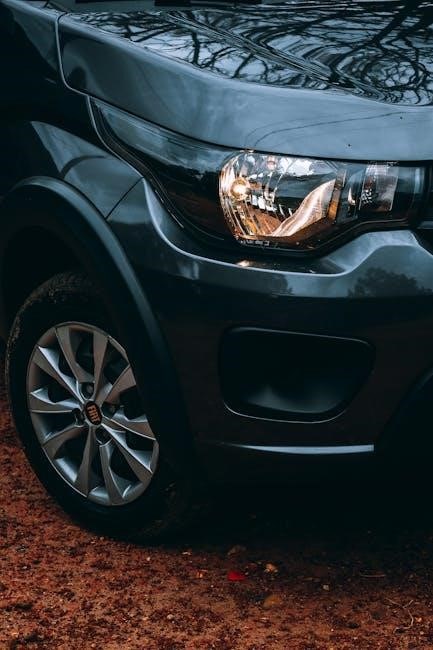Car headlight bulbs are essential for safety and visibility, ensuring proper illumination on the road. With various types like halogen, LED, and HID, choosing the right bulb is critical for optimal performance, safety, and compliance with vehicle specifications;
Overview of the Importance of Proper Headlight Bulbs
Proper headlight bulbs are crucial for safety, visibility, and driving confidence. They ensure clear illumination of the road ahead, reducing the risk of accidents, especially at night or in low-light conditions. Incorrect or faulty bulbs can impair vision, blind other drivers, or lead to traffic violations. Using bulbs that match your vehicle’s specifications guarantees optimal performance and compliance with safety standards. Additionally, energy-efficient options can lower power consumption while maintaining brightness. Investing in high-quality bulbs not only enhances safety but also contributes to the overall reliability and longevity of your vehicle’s lighting system. Proper headlight maintenance is essential for responsible driving.
Types of Car Headlight Bulbs
Car headlight bulbs come in various types, including halogen, LED, and HID/Xenon, each offering distinct brightness, energy efficiency, and durability. Choosing the right type ensures optimal lighting performance;
Halogen Bulbs: Features and Benefits
Halogen bulbs are the most common type of car headlight bulb, known for their reliability and long lifespan. They provide bright, white light and are relatively inexpensive compared to other options. Halogen bulbs are easy to install and widely available, making them a practical choice for many drivers. However, they are less energy-efficient than LED or HID bulbs and may produce more heat. Despite this, halogen bulbs remain a popular option due to their affordability and consistent performance, ensuring good visibility and safety on the road.
LED Bulbs: Advantages and Drawbacks
LED bulbs offer exceptional energy efficiency and a long lifespan, making them a popular choice for car headlights. They emit a bright, white light that enhances visibility, while their low power consumption reduces strain on the vehicle’s electrical system. LED bulbs are also eco-friendly and require less maintenance due to their durability. However, many LED bulbs are not DOT-approved for road use, and some models may scatter light, causing glare for other drivers. While they are cost-effective in the long run, their initial purchase price can be higher than traditional options. Choosing the right LED bulb ensures safety and optimal performance.
HID/Xenon Bulbs: Performance and Safety Considerations
HID/Xenon bulbs are renowned for their bright, white light, enhancing visibility on the road. They utilize high intensity discharge technology, surpassing halogen bulbs in brightness. This intense illumination, however, can pose safety risks if not properly aimed or approved, potentially causing glare for other drivers. While they offer a longer lifespan and energy efficiency, their higher cost and dependency on a ballast add complexity. It’s crucial to ensure they meet DOT standards to avoid safety hazards. Recommended for vehicles originally equipped with HID systems, they provide superior performance but require careful consideration due to their higher cost and potential safety implications if misused.

How to Choose the Right Headlight Bulb
Choosing the right headlight bulb requires matching your vehicle’s specifications, ensuring proper fitment, and considering brightness needs. Use online finders for accurate selection and safety.
Determining the Correct Bulb Type and Size for Your Vehicle
Determining the correct bulb type and size for your vehicle is crucial for safety and performance. Always consult your vehicle’s owner’s manual or the manufacturer’s guide to find the specific bulb requirements. You can also use online bulb finders by entering your vehicle’s make, model, and year to get accurate recommendations. Correct fitment ensures proper illumination and avoids legal issues. Additionally, verify the bulb’s wattage and base type to prevent damage to your car’s electrical system. Using the wrong bulb can lead to reduced visibility or system malfunctions, so double-checking is essential for optimal functionality and longevity of your headlight system.
Using Online Bulb Finders for Accurate Selection
Online bulb finders are invaluable tools for ensuring you select the correct headlight bulbs for your vehicle. By entering your car’s make, model, and year, these tools provide precise recommendations. They eliminate guesswork by filtering options based on your vehicle’s specifications. Many finders also allow you to search by bulb type or order number for added convenience. This ensures compatibility and optimal performance. Using an online bulb finder helps avoid purchasing the wrong size or type, which could lead to poor fitment or safety hazards. They are user-friendly, quick, and reliable, making the selection process efficient and stress-free for drivers of all experience levels.

Installation and Safety Tips
Proper installation ensures safety and performance. Always disconnect the battery, wear gloves, and avoid touching the bulb’s glass. Follow instructions carefully to prevent damage or injury.
Step-by-Step Guide to Replacing Headlight Bulbs
To replace your car’s headlight bulb, start by gathering tools and consulting your vehicle’s manual. Disconnect the battery for safety. Open the hood and locate the headlight assembly. Remove any covers or screws to access the bulb. Gently pull the connector from the old bulb and remove it. Insert the new bulb, ensuring it’s securely fastened. Reconnect the connector and reassemble the headlight. Turn on the headlights to test functionality. Properly dispose of the old bulb. Always follow manufacturer instructions for specific models to avoid damage or injury.
Safety Precautions to Avoid Damage or Injury
When replacing headlight bulbs, always disconnect the battery to prevent electric shocks. Wear protective gloves and goggles to avoid injury from broken glass. Ensure the vehicle is parked on a level surface and apply the handbrake for stability. Avoid touching the glass part of the new bulb with bare hands, as oils can reduce its lifespan. Use a cloth or gloves to handle the bulb. Never look directly at the bulb when testing, as it emits intense light. Keep children away from the process. Follow the manufacturer’s instructions precisely and ensure the car is turned off during replacement. Properly dispose of the old bulb and consult a professional if unsure.

Key Considerations for Upgrading Headlight Bulbs
Upgrading headlight bulbs requires considering energy efficiency, bulb lifespan, and environmental impact. Eco-friendly options like LEDs reduce power consumption and lower carbon emissions, promoting sustainability while enhancing performance.
Eco-Friendly and Cost-Efficient Options
LED bulbs are a top choice for eco-conscious drivers, offering significant energy savings and reduced carbon emissions. They consume less power than traditional halogen bulbs, lowering energy bills and extending battery life. Additionally, LEDs have a longer lifespan, reducing the need for frequent replacements and minimizing waste. Eco-friendly options also include energy-efficient HID/Xenon bulbs, which provide brighter light while using less power. Upgrading to these cost-efficient solutions not only benefits the environment but also saves money over time. With advancements in technology, future trends like laser and OLED bulbs promise even greater efficiency and sustainability for drivers seeking greener alternatives.
Future Trends: Laser and OLED Headlight Technology
Laser and OLED technologies are revolutionizing car headlights, offering unparalleled brightness, energy efficiency, and design flexibility. Laser headlights produce intense, focused beams with minimal power consumption, enhancing visibility while reducing strain on the vehicle’s electrical system. OLED (Organic Light Emitting Diode) technology promises even greater efficiency, with thin, lightweight panels that can be shaped to create dynamic lighting designs. Both technologies are expected to dominate the automotive industry, providing brighter, safer, and more sustainable lighting solutions. As these innovations advance, they will redefine headlight performance, combining style, functionality, and environmental benefits for future vehicles.
Troubleshooting Common Issues
Flickering or dim headlights often indicate faulty bulbs, wiring issues, or incompatible bulb types. Always check connections and ensure bulbs match your vehicle’s specifications for optimal performance.
Diagnosing Faulty or Dim Headlight Bulbs
Identifying issues with headlight bulbs involves checking for flickering, dimming, or uneven light output. Common causes include loose connections, worn-out bulbs, or incorrect bulb types. Start by inspecting the bulb for visible damage or corrosion. Ensure the bulb is securely fitted and connections are clean. If dimming persists, it may indicate a failing bulb or electrical system issues. Always verify compatibility with your vehicle’s specifications. Testing the bulb in another socket can help determine if the problem lies with the bulb or the wiring. Refer to your vehicle’s manual or consult a guide for precise diagnostic steps to resolve the issue effectively.
Proper headlight bulb maintenance ensures safety and visibility. Regular inspections, timely replacements, and using correct bulb types are crucial for optimal performance and road compliance.

Final Tips for Maintaining Optimal Headlight Performance
Regularly clean headlight lenses to prevent dirt buildup, which can reduce visibility. Inspect bulbs for signs of damage or dimming and replace them promptly. Ensure proper installation by following manufacturer guidelines to avoid misalignment or electrical issues. Consider upgrading to energy-efficient options like LEDs for better performance and longevity. Always use bulbs that match your vehicle’s specifications to maintain safety and performance. Avoid unauthorized modifications that could compromise light output or safety. Finally, consult a professional if unsure about replacements or upgrades to ensure your headlights function optimally for safe driving conditions.
